 W
WChina–India relations, also called Sino-Indian relations or Indian–Chinese relations, refers to the bilateral relationship between China and India. The tone of the relationship has varied over time; the two nations have sought economic cooperation with each other, while frequent border disputes and economic nationalism in both countries are a major point of contention. The modern relationship began in 1950 when India was among the first countries to end formal ties with the Republic of China (Taiwan) and recognize the People's Republic of China as the legitimate government of Mainland China. China and India are two of the major regional powers in Asia, and are the two most populous countries and among the fastest growing major economies in the world. Growth in diplomatic and economic influence has increased the significance of their bilateral relationship.
 W
WThe ways in which glass was exchanged throughout ancient times is intimately related to its production and is a stepping stone to learning about the economies and interactions of ancient societies. Because of its nature it can be shaped into a variety of forms and as such is found in different archaeological contexts, such as window panes, jewellery, or tableware. This is important because it can inform on how different industries of sections of societies related to each other – both within a cultural region or with foreign societies.
 W
WChinese-Greek relations are the relations between the People's Republic of China and the Hellenic Republic. China has an embassy in Athens. Greece has an embassy in Beijing and 3 general consulates in Guangzhou, Hong-Kong and since 2005 in Shanghai. The Port of Piraeus is important from a geostrategic view for China, as it helps China's transactions with the whole of Europe. Thousands of Chinese people are living in Greece in the Overseas Chinese context.
 W
WEgyptian–Greek relations refer to bilateral relations between Egypt and Greece. Due to the strong cultural and historical ties between the two nations, Egypt and Greece today enjoy friendly relations. Modern diplomatic relations between the two countries were established after Greece gained its independence in 1830, and are today regarded as cordial. Both countries are members and partners in several international organizations such as UN, IMF, OSCE, and the Union for the Mediterranean, among others.
 W
WEgypt–Mesopotamia relations were the relations between the civilisations of ancient Egypt and Mesopotamia, in the Middle East. They seem to have developed from the 4th millennium BCE, starting in the Uruk period for Mesopotamia and the Gerzean culture of Prehistoric Egypt. Influences can be seen in the visual arts of Egypt, in imported products, and also in the possible transfer of writing from Mesopotamia to Egypt and generated "deep-seated" parallels in the early stages of both cultures.
 W
WPhoenicia was an ancient Semitic-speaking thalassocratic civilization that originated in the Levant region of the eastern Mediterranean, primarily modern Lebanon. It was concentrated along the coast of Lebanon and included some coastal areas of modern Syria and Galilee, reaching as far north as Arwad and as far south as Acre and possibly Gaza. At its height between 1100 and 200 BC, Phoenician civilization spread across the Mediterranean, from the Levant to the Iberian Peninsula.
 W
WSoutheast Asia was under Indian sphere of cultural influence starting around 290 BC until around the 15th century, when Hindu-Buddhist influence was absorbed by local politics. Kingdoms in the southeast coast of the Indian Subcontinent had established trade, cultural and political relations with Southeast Asian kingdoms in Burma, Thailand, Indonesia, Malay Peninsula, Philippines, Cambodia and Champa. This led to Indianisation and Sanskritisation of Southeast Asia within Indosphere, Southeast Asian polities were the Indianised Hindu-Buddhist Mandala.
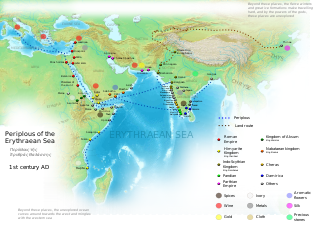 W
WIndo-Roman relations began during the reign of Augustus, the first emperor of the Roman Empire. The presence of Romans in the Scythia and India and the relations between these regions during the period of the Roman Empire are poorly documented. Before the conquests of Alexander in India, there are no surviving accounts by contemporaries or near-contemporaries, so modern understanding depends on more abundant literary, numismatic, and archaeological evidence, mainly relating to the trade between them.
 W
WIndo-Roman trade relations was trade between the Indian subcontinent and the Roman Empire in Europe and the Mediterranean Sea. Trade through the overland caravan routes via Asia Minor and the Middle East, though at a relative trickle compared to later times, antedated the southern trade route via the Red Sea and monsoons which started around the beginning of the Common Era (CE) following the reign of Augustus and his conquest of Egypt in 30 BCE.
 W
WIndus–Mesopotamia relations are thought to have developed during the second half of 3rd millennium BCE, until they came to a halt with the extinction of the Indus valley civilization after around 1900 BCE. Mesopotamia had already been an intermediary in the trade of lapis lazuli between South Asia and Egypt since at least about 3200 BCE, in the context of Egypt-Mesopotamia relations.
 W
WThe Sasanian or Sassanid Empire, officially known as the Empire of Iranians, and called the Neo-Persian Empire by historians, was the last Persian imperial dynasty before the Muslim conquest in the mid seventh century AD. Named after the House of Sasan, it endured for over four centuries, from 224 to 651 AD, making it the longest-lived Persian dynasty. The Sasanian Empire succeeded the Parthian Empire, and reestablished the Iranians as a superpower in late antiquity, alongside its neighbouring arch-rival, the Roman-Byzantine Empire.
 W
WCertain patterns emerged to govern the conduct of relations among the states of the Spring and Autumn period of ancient China. These patterns constituted a rudimentary system of interstate or international law based on the model of feudalism established under the Western Zhou. The norms of interstate relations during the Spring and Autumn period was one of the earliest systems of interstate relations and international law in the world. It was of importance in the early cultural and political development of China, allowing greater ease in maintaining relations, and facilitating the flow of trade and information. There was a growing body of customary international law which developed as contacts and commerce increased, a number of treaties were signed, and appeal was frequently made to rules set up within the leagues of states. A great many of the canons of interstate law concerned diplomacy among the states.
 W
WThe Japanese missions to Imperial China were diplomatic embassies which were intermittently sent to the Chinese court. Any distinction amongst diplomatic envoys sent from the Imperial Japanese court or from any of the Japanese shogunates was lost or rendered moot when the ambassador was received in the Chinese capital.
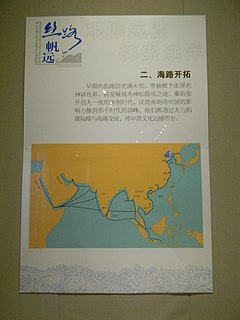 W
WThe Maritime Silk Road or Maritime Silk Route refers to the maritime section of the historic Silk Road that connected China, Southeast Asia, the Indian subcontinent, Arabian peninsula, Somalia, Egypt and Europe. It flourished between the 2nd century BC and 15th century AD. Despite its association with China in recent centuries, the Maritime Silk Road was primarily established and operated by Austronesian sailors in Southeast Asia, Tamil merchants in India and Southeast Asia, Greco-Roman merchants in East Africa, India, Ceylon and Indochina, and by Persian and Arab traders in the Arabian Sea and beyond.
 W
WThe Pax Assyriaca, Latin for "the Assyrian peace", was a relatively long period of peace in the Neo-Assyrian Empire during the 7th century .. The term was coined in parallel to Pax Romana. The Neo Assyrian Empire is notorious for its use of brute force to expand and maintain an empire after the Dark Ages of around 911–600 BC. However, their rule brought around a time period known as the Pax Assyriaca. During this time the Neo Assyrian Empire achieved its highest point of success, ranging from Egypt to the West, to the Persian Gulf in the East, and most of the Central Mediterranean area. The economic, political, ideological, and militant development during this period had lasting effects on the events even after the demise of the Assyrian Empire.
 W
WThe Minoan civilization was a Bronze Age Aegean civilization on the island of Crete and other Aegean Islands, flourishing from c. 3000 BC to c. 1450 BC until a late period of decline, finally ending around 1100 BC. It represents the first advanced civilization in Europe, leaving behind massive building complexes, tools, artwork, writing systems, and a massive network of trade. The civilization was rediscovered at the beginning of the 20th century through the work of British archaeologist Sir Arthur Evans. The name "Minoan" derives from the mythical King Minos and was coined by Evans, who identified the site at Knossos with the labyrinth and the Minotaur. The Minoan civilization has been described as the earliest of its kind in Europe, and historian Will Durant called the Minoans "the first link in the European chain".
 W
WPax Romana is a roughly 200-year-long timespan of Roman history which is identified as a period and golden age of increased as well as sustained Roman imperialism, order, prosperous stability, hegemonial power and expansion, despite a number of revolts, wars and continuing competition with Parthia. It is traditionally dated as commencing from the accession of Caesar Augustus, founder of the Roman principate, in 27 BC and concluding in 180 AD with the death of Marcus Aurelius, the last of the "Five Good Emperors". Since it was inaugurated by Augustus with the end of the Final War of the Roman Republic, it is sometimes called the Pax Augusta. During this period of approximately two centuries, the Roman Empire achieved its greatest territorial extent and its population reached a maximum of up to 70 million people. According to Cassius Dio, the dictatorial reign of Commodus, later followed by the Year of the Five Emperors and the crisis of the third century, marked the descent "from a kingdom of gold to one of iron and rust".
 W
WPax Sinica is a historiographical term referring to periods of peace and prosperity in East Asia, Northeast Asia, Southeast Asia, and Central Asia led by China. The multiple periods of Pax Sinica, when taken together, amounted to a length of approximately two thousand years.
 W
WThe Periplus of the Euxine Sea is a periplus or guidebook detailing the destinations visitors encounter when traveling about the shore of the Black Sea. It was written by Arrian of Nicomedia from AD 130-131.
 W
WSince the early 1900s the theory that Polynesians (Māori) were the first ethnic group to settle in New Zealand has been dominant among archaeologists and anthropologists. Before that time and until the 1920s, however, a small group of prominent anthropologists proposed that the Moriori people of the Chatham Islands represented a pre-Māori group of people from Melanesia, who once lived across all of New Zealand. While this idea lost favour among academics, it was widely published and incorporated into school textbooks which has extended its life in the popular imagination.
 W
WRelations between the Roman and Iranian states were established c. 92 BC. It was in 69 BC that the two states clashed for the first time; the political rivalry between the two empires would dominate much of Western Asia and Europe until 628. Initially commencing as a rivalry between the Parthians and Rome, from the 3rd to mid-7th centuries the Roman Empire and its rival Sassanid Persia were recognized as two of the leading powers in the world.
 W
WThe Silk Road was a network of trade routes which connected the East and West, and was central to the economic, cultural, political, and religious interactions between these regions from the 2nd century BCE to the 18th century. The Silk Road primarily refers to the land routes connecting East Asia and Southeast Asia with South Asia, Persia, the Arabian Peninsula, East Africa and Southern Europe.
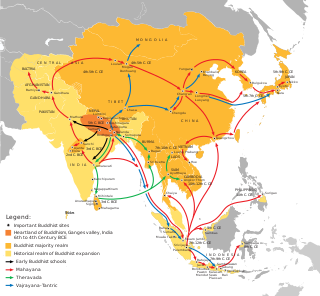 W
WBuddhism entered Han China via the Silk Road, beginning in the 1st or 2nd century CE. The first documented translation efforts by Buddhist monks in China were in the 2nd century CE via the Kushan Empire into the Chinese territory bordering the Tarim Basin under Kanishka. These contacts transmitted strands of Sarvastivadan and Tamrashatiya Buddhism throughout the Eastern world.
 W
WChina–Iran relations refer to the economic, political, and social relations between China and Iran from the 1979 Iranian Revolution to the present. Official relations began in 1937. The two civilizations have had a history of cultural, political, and economic exchanges along the Silk Road since at least 200 BC, and possibly earlier. To this day, China and Iran have developed a friendly economic and strategic partnership.
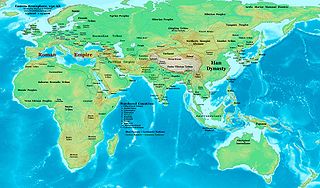 W
WSino-Roman relations comprised the mostly indirect contact, flow of trade goods, information, and occasional travellers between the Roman Empire and Han Empire of China, as well as between the later Eastern Roman Empire and various Chinese dynasties. These empires inched progressively closer in the course of the Roman expansion into the ancient Near East and simultaneous Han Chinese military incursions into Central Asia. Mutual awareness remained low, and firm knowledge about each other was limited. Only a few attempts at direct contact are known from records. Intermediate empires such as the Parthians and Kushans, seeking to maintain lucrative control over the silk trade, inhibited direct contact between these two Eurasian powers. In 97 AD, the Chinese general Ban Chao tried to send his envoy Gan Ying to Rome, but Gan was dissuaded by Parthians from venturing beyond the Persian Gulf. Several alleged Roman emissaries to China were recorded by ancient Chinese historians. The first one on record, supposedly from either the Roman emperor Antoninus Pius or his adopted son Marcus Aurelius, arrived in 166 AD. Others are recorded as arriving in 226 and 284 AD, with a long absence until the first recorded Byzantine embassy in 643 AD.
 W
WThe Steppe Route was an ancient overland route through the Eurasian Steppe that was an active precursor of the Silk Road. Silk and horses were traded as key commodities; secondary trade included furs, weapons, musical instruments, precious stones and jewels. This route extended for approximately 10,000 km (6,200 mi). Trans-Eurasian trade through the Steppe Route precedes the conventional date for the origins of the Silk Road by at least two millennia.
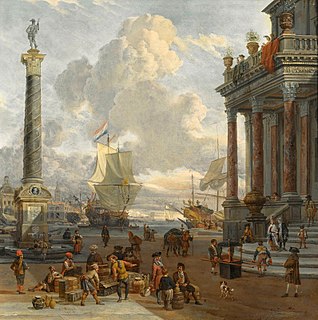 W
WThe history of international trade chronicles notable events that have affected the trade between various countries.